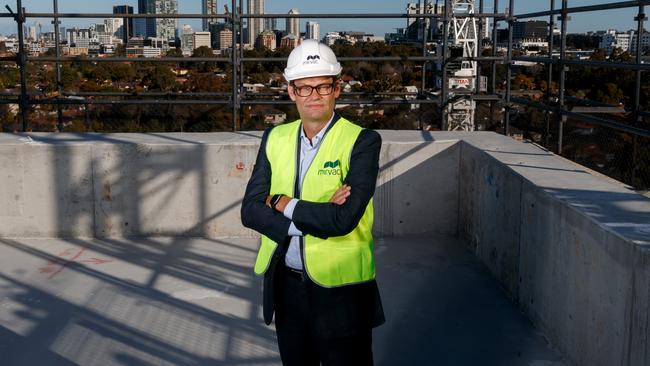CEO Survey 2025: Property groups eye growth as cost pressures stabilise
Leading property bosses say pricing pressures that have driven hundreds of construction firms out of business are stabilising, but energy and labour costs remain a concern.

CEO SURVEY 2025: FULL COVERAGE
Senior property executives say cost inflation is moderating within the home building industry after several tumultuous years, underpinning cautious optimism in their outlook for the sector.
But battle scars will remain as costs stabilise at historically high levels and easing price pressures for building materials are offset by more expensive labour and energy prices.
Chief executives of Australia’s largest listed property companies told The Australian’s CEO Survey their greatest cost concerns were labour and energy, while also calling on the federal government to sharpen its policy to tackle national housing affordability problems.
Lendlease chief executive Tony Lombardo said that, despite easing cost pressures and signs of price stabilisation, the new costs baseline was likely to remain well above pre-pandemic levels across the economy.
“We’ve seen cost pressures ease in certain areas,” Mr Lombardo said. “In construction, material price increases have slowed to near pre-pandemic levels, though labour costs remain high. While price increases are stabilising, the new baseline is likely here to stay across the economy.
“The easing cycle forecast for 2025 will support a recovery, and if there is sustained progress with cooling inflation, we’re likely to see the timing of rate cuts to be in line with expectations or even maybe quicker and sharper than consensus as the cost of living crunches household disposable income.”
Meanwhile, ahead of the federal election next year, Mirvac chief executive Campbell Hanan called on the federal government to improve its housing policy to boost supply.
“There is a chronic undersupply of housing in Australia and policy that helps to enable new supply will be a critical part of addressing Australia’s affordability challenges,” Mr Hanan said.
He said costs remained elevated across its apartments and commercial properties, despite a stabilisation in construction cost inflation.
“This is largely due to a shortage of skilled labour, which has been the biggest contributor of cost escalation and loss in productivity, coupled with a record number of subcontractor insolvencies throughout the year,” he said.
Mr Hanan said increased skilled migration and planning reforms were required to lift productivity in the industry and improve the supply and diversity of housing, as well as to make the country more attractive to global investment.

The nation has seen a deterioration in housing affordability, which has been fuelled by a chronic undersupply of housing, coupled with skyrocketing construction costs. This made the barrier of entering the market more difficult for first-home buyers and for people more broadly to upgrade into a family home.
Insolvencies in the construction sector have also surged in recent years.
Data from the Australian Securities & Investments Commission shows there were 1650 insolvency appointments in the financial year to December 8, a 28 per cent rise from the same period in 2023.
While construction businesses remained the main contributor to a record start to a financial year for insolvency appointments, the sector’s annual increase is significantly less than a 75 per cent jump in hospitality businesses and the overall rate.
Dexus CEO Ross Du Vernet said: “If we look at our business, the labour market remains tough and cost pressures exist, energy prices are also an issue. In the procurement and construction market, things have certainly been cooling, which is a positive signal.
“Rate cuts will have a big impact on investor confidence, and we should see stronger volumes in commercial real estate transactions.
“We see lots of opportunity in this market to invest and are actively working to deploy capital alongside clients.”

Pricing pressures on most building materials have decreased in line with softening demand over recent quarters, moderating overall price growth.
Data from the Australian Bureau of Statistics shows that residential property material costs rose 1.4 per cent in the year to September 30, compared to 4.4 per cent in the previous year. Both are sharply down on the 16 per cent rise in the year to September 30, 2022.
However, building materials containing copper rose this quarter due to elevated copper prices through the first half of 2024. Partially offsetting this was a 1.2 per cent decline in the price of plumbing products.
The Reserve Bank this month signalled that overall wages growth was easing faster than expected and could lead to a reduction in rates sooner than expected, the construction sector has seen a sharp increase in salaries. Construction workers in the eastern states and belonging to the CFMEU have received above-inflation wage rises.

Goodman Group chief executive Greg Goodman said inflation was a consistent problem around the world that needed to be dealt with. He said ultimately rates were going to be higher for longer than people would like.
“In this high-cost environment, we’re focused on productivity and getting more out of less. We’re working with our customers to help them do the same – getting more efficiency out of the data centres and logistics properties they have with us,” he said.
Mr Goodman said demand was holding up because it had been driven by the need for greater productivity: “What we want to see in the Australian economy is more emphasis on productivity and more encouragement and incentives for businesses to grow.”
Mr Hanan said Mirvac had been positioning itself to capitalise on the green shoots emerging in the economy that would be accelerated with the reduction of interest rates expected by the middle of 2025.
“We remain disciplined in our investment spend and manage our balance sheet prudently; we will look to do more capital partnering across our projects to improve the velocity of our capital and unlock value,” he said.
More Coverage
Originally published as CEO Survey 2025: Property groups eye growth as cost pressures stabilise





